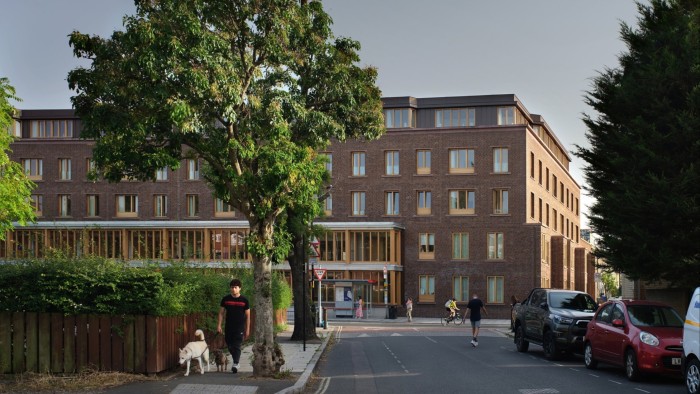Unlock the Editor’s Digest for free
Roula Khalaf, Editor of the FT, selects her favourite stories in this weekly newsletter.
Retirement housing may not seem the sexiest branch of architecture. Yet it is exactly what won architects Witherford Watson Mann this year’s Riba Stirling Prize, the UK’s most prestigious architectural award.
But then Appleby Blue, the vertical reinterpretation of an almshouse on London’s busy Southwark Park Road, is not at all what you would expect from elder housing. This is no suburban, low-density banality of lawns and lino but a solid, brick building with real presence and charisma in the streetscape. Unashamedly urban.
Instead of assuming that older people would like to be put out to pasture, it suggests they might be happier in the streets they are familiar with and with all the amenities the capital has to offer.
 The courtyard features timber facades, trees and a central water feature © Philip Vile/RIBA
The courtyard features timber facades, trees and a central water feature © Philip Vile/RIBA The garden terrace has raised concrete planters with lush greenery © Philip Vile/RIBA
The garden terrace has raised concrete planters with lush greenery © Philip Vile/RIBA
Appleby Blue also manages to be light, generous and green, its centre characterised by a capacious courtyard with trees and shrubs and a verdant roof terrace. The apartments may be relatively minimal — this is London after all — but the corridors which connect them are nothing like the institutional, strip-lit dead zones you might expect. Instead they are accessed via broad walkways with benches looking on to the courtyard, generous communal spaces intended to nurture everyday interaction. A large space used for dining and events has its glazing directly on to the street so that the building becomes part of the city rather than a retreat.
Witherford Watson Mann was a surprise Stirling Prize winner back in 2013, when it created a holiday destination with its remarkable restoration of the ruins of Astley Castle.
Speaking on behalf of the jury, Ingrid Schroder, director of London’s Architectural Association, said Appleby Blue’s architects had “crafted high-quality spaces that are generous and thoughtful, blending function and community to create environments that truly care for their residents”.
“This project is a clarion call for a new form of housing at a pivotal moment,” she continued. “Built against the backdrop of two crises, an acute housing shortage and a growing loneliness epidemic among older people, Appleby Blue offers a hopeful and imaginative response, where residents and the surrounding community are brought together through the transformative nature of the design.”
 The development has an open dining area © Philip Vile/RIBA
The development has an open dining area © Philip Vile/RIBA And large wooden-framed bay windows feature © Philip Vile/RIBA
And large wooden-framed bay windows feature © Philip Vile/RIBA
The architects won against a shortlist which included Swiss giants Herzog & de Meuron for the Discovery Centre, AstraZeneca’s huge R&D facility in Cambridge, Purcell for their restoration of Palace of Westminster’s Elizabeth Tower — colloquially known as Big Ben — and Allies and Morrison’s substantial London College of Fashion in Stratford, east London. Also on the list were a couple of smaller domestic projects: the renovation and extension of a Victorian house set into a hillside in Hastings by Hugh Strange, and Niwa House by Takero Shimazaki which brings a Japanese sensibility to a south London site.
Last year’s prize went to the Elizabeth Line, a piece of infrastructure once much-criticised for being overdue and over budget which now looks indispensable and visionary. The shift this year to the UK’s perennial housing problem throws a spotlight on not only the integration of communities but also the dire quality of most contemporary housing design.
Witherford Watson Mann’s Appleby Blue is a reaction to the inane suburbanity and car-centred development which still makes up the bulk of British housing, and to the clunky investment towers continuing to blight the city centres.
The building, managed by United St Saviour’s Charity, follows and restores the line of the old high street, repairing the cityscape and making housing a civic as well as a domestic concern. It would be good to think this prize might encourage other, more sophisticated housing interventions — it is a very fine role model indeed.
